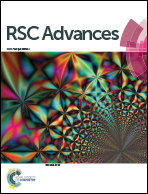Fluorescence quenching between unbonded graphene quantum dots and gold nanoparticles upon simple mixing†
Abstract
Fluorescence quenching is an interesting phenomenon that has been widely utilized in developing fluorescence-based sensors. However, most of the research focuses on the quencher and fluorophore in the bonded states. The fluorescence quenching between two unbonded nanostructures has been rarely studied. In this work, we observed and studied the fluorescence-quenching phenomenon between the unbonded gold nanoparticles (Au NPs) and graphene quantum dots (GQDs) upon simple mixing. We observed that the fluorescence of GQDs gradually decreased with the increase of Au NP concentration. This fluorescence quenching between unbonded GQDs and Au NPs obeys the nonlinear form of the Stern–Volmer model, which suggests that the process contains both static and dynamic quenching.


 Please wait while we load your content...
Please wait while we load your content...